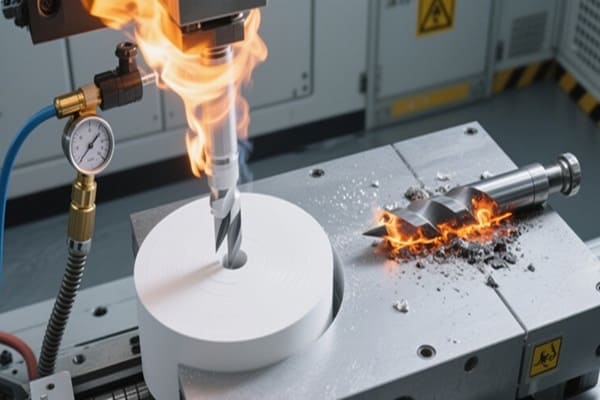Benefits of Wurtzite Boron Nitride in High-Performance Cutting Tools
Wurtzite boron nitride (WBN) is rapidly gaining attention in the manufacturing and materials engineering world as a groundbreaking material for high-performance cutting tools. Its remarkable hardness, excellent thermal stability, and chemical inertness position it as a leading choice for machining extremely hard and wear-resistant materials. This article explores the key benefits of WBN in cutting tools, comparing it with traditional materials, examining how it’s incorporated in manufacturing, and outlining its future potential. If you’re involved in industries like aerospace, automotive, or precision manufacturing, understanding WBN’s unique advantages can help you optimize tool performance and reduce operational costs.
At Advanced Ceramic Hub, we specialize in high-quality wurtzite boron nitride products, ensuring optimal performance for industrial and scientific applications.

What is Wurtzite Boron Nitride?
Wurtzite boron nitride is a polymorph of boron nitride with a hexagonal crystal structure that resembles diamond. This structure imparts exceptional hardness, making WBN one of the hardest materials known. Its mechanical strength and resistance to thermal degradation surpass those of many commonly used ceramic and carbide materials. Besides hardness, WBN exhibits excellent chemical stability, making it ideal for harsh machining environments.
| Property | Value | Unit |
| Hardness (Vickers) | ~40 | GPa |
| Thermal Stability | Up to 850 | °C |
| Young’s Modulus | ~900 | GPa |
| Electrical Conductivity | Insulator | – |
The extraordinary hardness and thermal stability allow WBN to maintain tool sharpness and durability, even under extreme cutting conditions.
Explore our high-quality wurtzite boron nitride products.
Why is Wurtzite Boron Nitride Ideal for Cutting Tools?
Cutting tools must withstand constant mechanical wear, high temperatures, and chemical exposure during machining processes. WBNoffers several unique benefits:
- Ultra-high hardness: WBN surpasses the hardness of tungsten carbide and many ceramics, enabling cutting tools to retain sharp edges longer and resist abrasive wear.
- Thermal stability: It maintains mechanical properties at temperatures where many materials degrade, supporting high-speed cutting and reducing tool failure.
- Chemical inertness: WBN resists oxidation and corrosion, increasing lifespan in chemically aggressive environments.
- Wear resistance: Its durability under mechanical stress reduces the need for frequent tool replacement, lowering downtime and costs.
- Precision compatibility: Suitable for advanced manufacturing that requires micron-level precision.
These properties make WBN cutting tools highly effective for machining tough alloys and superhard materials.
| Benefits of WBN for Cutting Tools | Description |
| Ultra-high hardness | Maintains sharpness, reduces wear |
| Thermal stability | Performs under high-temperature use |
| Chemical inertness | Resists corrosion and oxidation |
| Extended tool life | Reduces downtime and replacement costs |
| Precision machining compatibility | Supports micron-level accuracy |
How is Wurtzite Boron Nitride Incorporated into Cutting Tools?
The manufacturing of WBN cutting tools involves sophisticated methods to maximize their exceptional properties. Two common approaches are powder metallurgy and coating techniques:
- Powder Metallurgy: WBN powders are mixed with binders and sintered under high pressure to form solid tool components. This ensures uniform hardness distribution and structural integrity.
- Chemical Vapor Deposition (CVD): A thin layer of WBNis deposited onto a substrate (like tungsten carbide), creating a superhard coating that significantly improves wear resistance without altering the tool’s geometry.
- Hot Isostatic Pressing (HIP): Used to increase density and reduce defects in WBNtool parts, improving toughness and fracture resistance.
- These techniques are key to producing cutting tools that deliver superior performance in demanding machining applications.
| Manufacturing Technique | Description | Advantages |
| Powder Metallurgy | Mixing and sintering WBNpowders | Cost-effective, uniform hardness |
| Chemical Vapor Deposition (CVD) | Depositing WBN as a thin coating | Enhanced wear resistance, thin layer |
| Hot Isostatic Pressing (HIP) | High-pressure densification | Increased toughness, reduced defects |
What Are the Comparative Advantages of Wurtzite Boron Nitride Over Other Cutting Tool Materials?
To appreciate wBN’s benefits, it’s important to compare it with other common cutting tool materials like tungsten carbide (WC), cubic boron nitride (cBN), and silicon nitride (Si3N4). While WC is widely used for general machining, it suffers from lower thermal resistance and hardness compared to wBN. Cubic BN is very hard and stable, but typically more expensive and less thermally stable than wBN. Silicon nitride is tough but lacks the extreme hardness needed for certain applications.
| Material | Hardness (GPa) | Max Operating Temp (°C) | Wear Resistance | Cost Level |
| Tungsten Carbide | 18-22 | 700 | Moderate | Moderate |
| Cubic Boron Nitride (CBN) | 35 | 1000 | High | High |
| Silicon Nitride | 15 | 1400 | Moderate | Moderate |
| Wurtzite Boron Nitride (wBN) | ~40 | 850 | Very High | High |
WBN’s superior hardness and wear resistance enable it to cut tougher materials with longer tool life, justifying the investment in applications that demand peak performance.
Request a custom quote for the wurtzite boron nitride product.
What Industries Benefit Most from Wurtzite Boron Nitride Cutting Tools?
WBN cutting tools have found particular use in industries that require machining of superalloys, hardened steels, and exotic materials. The aerospace sector benefits from WBN tools in turbine blade manufacturing, where precision and wear resistance are critical. Automotive manufacturers use WBN tools for engine parts requiring high accuracy and durability. Oil and gas drilling tool production also leverages wBN’s wear resistance to withstand harsh conditions.
| Industry | Application Area | Benefits of WBNCutting Tools |
| Aerospace | Turbine blade machining | High precision, extreme wear resistance |
| Automotive | Engine components | Durability under mechanical stress |
| Oil & Gas | Drilling tool manufacturing | Corrosion resistance, long tool life |
| Electronics | Semiconductor fabrication | Precision machining, minimal contamination |
| Mold & Die Making | Precision molds and dies | Wear resistance and dimensional stability |
What Are the Challenges and Future Trends of Wurtzite Boron Nitride Cutting Tools?
Despite the advantages, challenges exist in WBN cutting tool adoption:
- High production cost due to complex synthesis and processing methods.
- Brittleness requires reinforcement to prevent cracking.
- Coating adhesion difficulties on substrates.
Ongoing research is addressing these issues with innovations such as:
- Development of nanostructured composites to improve toughness.
- Scalable, cost-effective synthesis techniques for mass production.
- Advanced surface treatments to enhance coating adhesion and durability.
These advances promise to make WBNtools more accessible and reliable for a wider range of applications.
| Challenge | Current Solutions | Future Prospects |
| High production cost | Optimizing HPHT synthesis | Scalable manufacturing methods |
| Brittleness | Composite reinforcement | Nanostructured toughening |
| Coating adhesion | Surface treatment improvements | Advanced bonding technologies |
FAQ
| Question | Answer |
| What makes WBN harder than others? | Its unique wurtzite crystal structure imparts ultra-high hardness. |
| Can WBN tools machine all metals? | Best for superalloys and hard metals; not always cost-effective for soft metals. |
| Are WBN cutting tools commercially available? | Yes, mostly in high-end, specialized industrial sectors. |
| How does the WBN tool’s lifespan compare to tungsten carbide? | Typically 2-3 times longer under similar conditions. |
| Is WBN safe to handle? | Yes, chemically inert and safe with normal handling precautions. |
Conclusion
Wurtzite boron nitride cutting tools provide unmatched hardness, wear resistance, and thermal stability that meet the needs of high-performance machining in aerospace, automotive, energy, and precision manufacturing industries. While challenges such as production cost and brittleness remain, ongoing advances in material science and manufacturing methods are paving the way for wider adoption. For projects demanding exceptional durability and precision, WBNcutting tools offer significant operational and cost-saving benefits. Understanding these advantages and challenges will help you make an informed choice when selecting materials for your cutting applications.
Looking for high-quality wurtzite boron nitride products? Contact us today!
